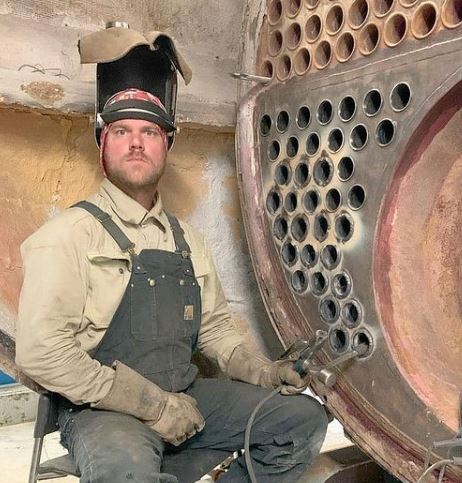Tig welding is a popular method for welding the various metals used in shipbuilding, including carbon steel, stainless steel, and aluminum. It is a precise and highly skilled process that requires the welder to have a steady hand and good control over the welding torch. This comprehensive guide will cover the principles of tig welding and provide tips and techniques for successful welds in the shipbuilding industry. We will discuss the proper preparation of materials, the right filler metal and tungsten electrode selection, and the proper torch technique.
We will also cover some of the unique challenges that may arise when tig welding in the shipbuilding industry and provide solutions for overcoming them. Following these guidelines, you can produce strong, high-quality welds for shipbuilding using tig welding.

Tig Welding for Shipbuilding
This article will provide a comprehensive guide to tig welding in shipbuilding, including an overview of the process, safety considerations, and advanced techniques.
Preparing for Tig Welding in Shipbuilding
Before you begin tig welding in shipbuilding, taking the necessary safety precautions is important. This includes wearing protective gear, such as a welding helmet, gloves, and long sleeves to protect your skin from the arc. It’s also important to work in a well-ventilated area to reduce the risk of inhaling toxic fumes.
Choosing the right filler metal and shielding gas is also important for successful tig welding in shipbuilding. The filler metal should be appropriate for the material you are welding and the strength of the weld you need. A mixture of argon and CO2 is often recommended for shielding gas, but the specific mix will depend on the type of material you are welding and the specific application.
Before you begin welding, it’s also important to prepare the workpiece. This includes cleaning the joint and ensuring it is properly aligned and secure. Preheating the workpiece can also reduce the risk of warping and distortion during the welding process.
Setting Up the Machine for Shipbuilding
To get the most out of your tig welding machine, it’s important to set it up correctly. This includes adjusting the amperage and voltage to the correct levels for the material you are welding and the thickness of the workpiece. It’s also important to choose the correct tungsten electrode, which should match the type of material you are welding and the amperage you are using.
You’ll also need to set up the gas flow. The correct flow rate will depend on the size of the tungsten electrode and the weld puddle. Too little gas can result in an unstable arc and poor weld quality, while too much gas can result in excessive spatter and reduced penetration.
Tips and Tricks
Once you have your equipment set up, you’re ready to begin welding. One of the keys to successful tig welding in shipbuilding is maintaining proper arc length and travel speed. The arc length should be kept consistent and should not be allowed to become too long or too short. The travel speed should also be kept consistent and adjusted based on the size of the weld puddle.
Controlling the weld puddle is also important in tig welding. The weld puddle is the molten pool of filler and base metal that forms during the welding process. Proper puddle control allows you to shape the weld and fill the joint, resulting in a strong, high-quality weld. You’ll need to use your wrist to manipulate the tungsten electrode and filler wire as needed to control the puddle.
Finally, it’s important to avoid common mistakes when welding in shipbuilding. This includes not using enough filler metal, not cleaning the joint properly, and not maintaining a consistent arc length and travel speed. By avoiding these mistakes, you can increase the chances of success and produce high-quality welds.
Advanced Techniques
Once you’ve mastered the basics of tig welding, you can try more advanced techniques to take your skills to the next level. One advanced technique is back purging, which involves using a separate gas flow to protect the back side of the weld from oxygen. This can be useful for welding materials prone to oxide formation, such as stainless steel.
Another advanced technique is pulse welding, which involves rapidly switching the welding current on and off in a controlled manner. Pulse welding can reduce heat input and improve the overall quality of the weld.
Finally, using a foot pedal to control the welding current can also be a useful advanced technique. This gives you more precise control over the welding process and can help you produce high-quality welds more consistently.
Why Is Tig Welding So Difficult?
TIG welding, or tungsten inert gas welding, is a complex process requiring high skill and precision. TIG welding can be difficult because it requires a non-consumable tungsten electrode to create the electric arc that is used to heat and melt the metal being welded. This requires the welder to have good hand-eye coordination and the ability to maintain a consistent arc length and welding speed. TIG welding also requires filler metal and shielding gas, which can add to the complexity of the process.
How Much Do Nasa Tig Welders Make?
It isn’t easy to provide an exact figure for how much TIG welders at NASA make, as wages can vary depending on factors such as the individual’s experience level, education, and location. According to data from the U.S. Bureau of Labor Statistics, the median annual wage for welders, cutters, solderers, and brazers in the United States was $44,480 as of May 2020. However, wages for welders working for the federal government, such as those at NASA, may be higher due to the work’s specialized nature and the required skill level.
Do You Push Or Pull When You Tig Weld?
When TIG welding, the direction in which the filler metal is added to the weld joint can affect the quality of the weld. It is generally best to push the filler metal into the weld joint, as this can help create a smoother and more consistent bead. Pushing the filler metal also allows the welder to have better control over the welding process and avoid overheating the metal, which can lead to defects in the weld.
What Should You Not Do When Tig Welding?
Here are a few things to avoid when TIG welding:
- Do not overheat the metal: TIG welding requires precise control of the temperature of the metal being welded. Overheating the metal can lead to defects in the weld and weaken the weld joint’s strength.
- Do not use contaminated filler metal: Using contaminated filler metal can lead to defects in the weld and can also weaken the strength of the weld joint. It is important to use clean, high-quality filler metal to ensure the best possible results.
- Use the right type of shielding gas: Different types of shielding gases are used for different types of metals and welding applications. Using the wrong type of shielding gas can lead to defects in the weld and can also affect the strength of the weld joint.
- Please do not neglect to use proper personal protective equipment (PPE): TIG welding can produce harmful fumes and radiation, so it is important to wear appropriate PPE, such as a welding helmet, gloves, and fire-resistant clothing to protect yourself from these hazards.
How Long Does It Take To Master Tig?
Becoming proficient in TIG welding can take significant time and practice. The amount of time it takes to master TIG welding will vary depending on factors such as the individual’s level of aptitude, dedication, and the amount of practice they can put in. It can take several months to a year or more of regular practice to become proficient in TIG welding. It is important to be patient and to take the time to learn the proper techniques and best practices to ensure the best possible results.
Conclusion
Tig welding is a valuable tool for shipbuilding, allowing you to produce strong, durable welds free of defects. By following the right techniques and using the right equipment, you can achieve high-quality welds that can withstand the harsh conditions of the marine environment. It’s important to take the necessary safety precautions and to practice and seek training to improve your skills. With the right approach, tig welding can be reliable and efficient for creating strong, durable welds in shipbuilding.

It’s been years since I got into welding as a side hustle. It’s been so long since Doing All kinds of welds for business and pleasure as this is my hobby. Being in this field I have learned from hands-on-experience also came to know what gears work and what doesn’t. The Tig Welder is my own platform where I use to share my experience.






Leave a Reply